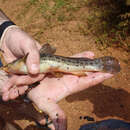Diagnostic Description
provided by Fishbase
Diagnosis: combined premaxillary tooth plate very broad, 33.5-41.7% of head length vs. 30.1-35.3% in N. boutchangai, and less than 30% in the other species; eye diameter large, 9.1-13.3% of head length vs. smaller in N. maculatum, N. pallidum and N. depierrei, but overlapping with eye size range of the other species; interorbital distance rather large, 28.0-36.6% of head length vs. 24.0% or less in N. akiri, N. depierrei, N. pallidum and N. pembetadi; only 7 soft dorsal-fin rays vs. more than 8 in N. depierrei, N. maculatum, N. pallidum, N. pembetadi, N. thomasi and N. walkeri; dorsal fin spine rather long, 6.9-14.7% of standard length vs. shorter in N. depierrei, N. maculatum, N. pembetadi and N. thomasi (Ref. 94168).Description: body and head rather depressed, pre-dorsal body depth 16.1-18.0% of standard length, minimal caudal peduncle depth 13.2-15.9% of standard length, head depth 45.9-60.0% of head length; branchiostegal membranes each supported by 12 rays, almost not fused, separated by a deep medial slit, possibly overlapping; total number of 38 vertebrae; dorsal fin relatively high and rounded, spine 6.9-14.7% of standard length; 7 branched dorsal-fin rays; adipose fin moderately deep, 4.0-6.2% of standard length (Ref. 94168).Colouration: dark brownish gray to pale yellow with numerous black or brown spots and blotches on the head, body and fins, often aligned in transverse bands along the flanks; juvenile colouration more variable, with larger, often confluent blotches, only yellow and light and dark brown alternating bands visible (Ref. 81642, 94168; above colouration refers to live specimens in Ref. 94168 but preserved specimens in Ref. 81642).
Morphology
provided by Fishbase
Dorsal spines (total): 2; Dorsal soft rays (total): 7 - 8; Analspines: 0; Analsoft rays: 10 - 12; Vertebrae: 38
Biology
provided by Fishbase
Feeding on a wide variety of foods, including such things as fish fry and eggs, crustaceans, insect larvae, and plant material (Ref. 6868).
Notoglanidium macrostoma: Brief Summary
provided by wikipedia EN
Notoglanidium macrostoma, also called the flatnose catfish and dwarf giraffe catfish is a species of claroteid catfish found in rivers in Angola, Cameroon, the Democratic Republic of the Congo, the Republic of the Congo and Gabon. It is active during twilight and at night and its diet consists of small fishes, crustaceans and insect larvae. It grows to a length of 24.0 cm (9.4 inches) TL.
- license
- cc-by-sa-3.0
- copyright
- Wikipedia authors and editors
Notoglanidium macrostoma: Brief Summary
(
Spanish; Castilian
)
provided by wikipedia ES
Notoglanidium macrostoma es una especie de peces de la familia Claroteidae en el orden de los Siluriformes.
- license
- cc-by-sa-3.0
- copyright
- Autores y editores de Wikipedia
Anaspidoglanis macrostomus
(
Basque
)
provided by wikipedia EU
(RLQ=window.RLQ||[]).push(function(){mw.log.warn("Gadget "ErrefAurrebista" was not loaded. Please migrate it to use ResourceLoader. See u003Chttps://eu.wikipedia.org/wiki/Berezi:Gadgetaku003E.");});
- license
- cc-by-sa-3.0
- copyright
- Wikipediako egileak eta editoreak
Anaspidoglanis macrostomus: Brief Summary
(
Basque
)
provided by wikipedia EU
Anaspidoglanis macrostomus Anaspidoglanis generoko animalia da. Arrainen barruko Claroteidae familian sailkatzen da.
- license
- cc-by-sa-3.0
- copyright
- Wikipediako egileak eta editoreak

